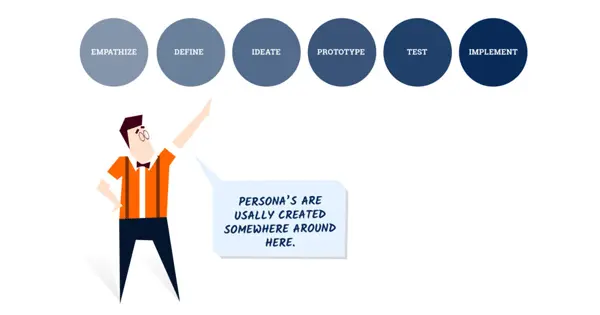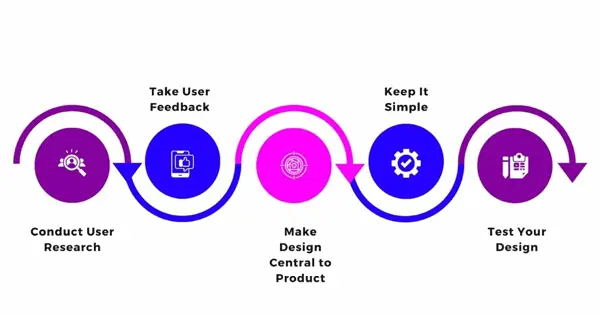7 Expert Tips for Powerful User-Centered Designs in 2025
Written by UIDesignz Feb 22, 2023 4 min read
Last updated: Dec 30 2024

Creating a user-friendly design at UIDesignz means knowing exactly what users need. We aim to create designs that are simple, fun, and helpful for users to achieve their goals. We focus on understanding users, being empathetic, and creating products that are easy to use. Our priority is not just making things usable but ensuring a great user experience, considering emotions and accessibility for everyone, even those with disabilities.
Table of Contents
Define User Personas
Before going through the designing process, define your target audience through user personas. These detailed representations help UI UX design agency empathize with users, inform design decisions, increase shared team understanding, and enable a focus on specific user needs. User personas are instrumental in aligning the design with user goals and preferences. This tip is helpful in.
- Empathy-driven design.
- Informed decision-making.
- Shared team understanding.
- Tailoring design to specific user needs.

User Personas (image by Pietalberts)
Conduct User Research
User research is important for a user-centered design, providing insights into user needs, expectations, and pain points. Techniques like surveys, interviews, and usability testing offer a deep understanding of the target audience, leading to innovative designs, enhanced user satisfaction, and a more successful product or UI UX design service. It's helpful for
- In-depth user understanding.
- Identification of user needs and pain points.
- Validation of design assumptions.
- Opportunities for innovation and differentiation.
Keep It Simple
Simplicity is most important in user-centered design. A simple design enhances usability, reduces cognitive load, and improves accessibility for a diverse user base. Clear language, limited options, and a focus on critical features ensure users can navigate the design effortlessly, leading to a positive user experience. It helps in
- Improved usability.
- Reduced cognitive load.
- Enhanced accessibility.
- Minimized learning curve.
Make it Intuitive
An intuitive design ensures users can achieve their goals effortlessly. By incorporating familiar elements and design patterns, such as navigation menus and icons, designers can reduce cognitive effort, making the design more efficient and effective. Intuitive designs also contribute to higher user satisfaction and quicker user adoption. It also increases
- Usability and accessibility.
- Reduced learning time.
- Prevention of errors.
- Enhanced user experience and satisfaction.

Make it Intuitive (image by Chisel Glossary)
Read More: Importance of UI UX Design for Businesses
Use Visual Hierarchy
Visual hierarchy guides users through a design by organizing elements based on importance. Employing size, color pallete, contrast, and spacing creates a structured visual flow, improving usability, readability, and guiding user attention to essential information. A well-implemented visual hierarchy enhances user engagement and satisfaction. Plus beneficial for.
- Improved usability.
- Enhanced readability.
- Guided user attention.
- Increased engagement.
Prioritize Accessibility
Designing with accessibility in mind ensures inclusivity for users of all abilities. Features like alt text, keyboard navigation, and high-contrast color schemes improve usability for individuals with disabilities. Prioritizing accessibility aligns with legal requirements, promotes ethical responsibility, and enhances overall user satisfaction.
- Improved usability for all users.
- Increased user satisfaction.
- Ethical and social responsibility.
- Compliance with legal requirements.
Keep Reading: App Design Techniques for Seamless User Navigation
Test and Iterate
Usability testing is vital for refining a user-centered design. Continuously testing and iterating based on user feedback ensures the design aligns with user expectations, enhances user satisfaction, and addresses any usability or accessibility issues that may arise during development. This technique
- Ensures usability.
- Improves user satisfaction.
- Addresses accessibility concerns.
- Enhances the effectiveness of the final design.

Test and Iterate (image by Aug)
Conclusion
Incorporating these principles into the user-centered design process will not only result in a product or service that meets user needs but will also promote a positive and engaging user experience. By prioritizing empathy, accessibility, simplicity, and continuous improvement through testing, designers can create powerful designs that truly meet with their target audience.
To avail our offered services by Professionals kindly Contact Us.





